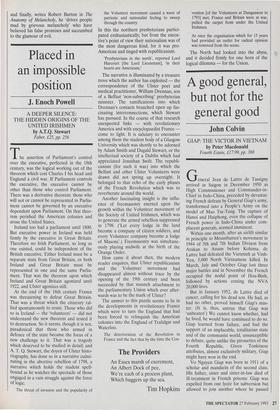A good general, but not for the general good
John Colvin
GIAP: THE VICTOR IN VIETNAM by Peter Macdonald Fourth Estate, £17.99, pp. 368 General Jean de Lattre de Tassigny arrived in Saigon in December 1950 as High Commissioner and Commander-in- Chief in Indo-China, preceded by devastat- ing French defeats by General Giap's army, transformed into a People's Army on the model of Mao Tse-Tung. The capture of Hanoi and Haiphong, even the collapse of French power in Indo-China under com- placent generals, seemed imminent.
Within one month, after an airlift similar in principle to Mountbatten's movement in 1944 of 5th and 7th Indian Divison from Arakan to Assam before Kohima, de Lattre had defeated the Vietminh at Vinh- Yen, 5,000 North Vietnamese killed. In March, July and October Giap lost three major battles and in November the French occupied the nodal point of Hoa-Binh, followed by actions costing the NVA 20,000 lives.
But in January 1952, de Lattre died of cancer, calling for his dead son. He had, as had no other, proved himself Giap's mas- ter. (It is, thus, untrue that Giap was `unbeaten') We cannot know whether, had he lived, he would have continued to do so. Giap learned from failure, and had the support of an implacable, totalitarian state and of the communist world, unsusceptible to debate, quite unlike the pirouettes of the Fourth Republic. Given Tonkinese attributes, almost exclusively military, Giap might have won in the end.
Vo Nguyen Giap was born in 1911 of a scholar and mandarin of the second class. His father, sister and sister-in-law died of ill-treatment in French prisons: Giap was expelled from one lycee for subversion but allowed to join another where he passed
his baccalaureat. In 1937, he joined the Communist Party, escaping in 1940 to China where he met Ho Chi Minh and Pham Van Dong in Mao's base. He studied communist military doctrine, joined the Vietminh as a founder member and returned to Indo-China in 1942 where he founded what was to become the North Vietnamese Army.
Its forces grew from 34, helped by the American OSS, to 50,000 in 1945, aided by Japanese deserters and armed through Thailand, Hong Kong and by the Chinese communists, increasingly successful until de Lattre's victories. Thereafter Giap became a 'military commander, not a guer- rilla leader', his successes culminating in the French failure to understand him before Dien Bien Phu, their defeat and departure.
The Americans, in their turn, made things even easier for Giap. To have unleashed massive aerial technology against Haiphong and the marshalling- yards on the Chinese border would have decisively restricted — and without sub- stantial civilian casualties — those external supplies enabling Hanoi to win the war in the south. Instead, from baseless fear of China, they fell into a land war which their culture precluded them from winning. That campaign led to frightful damage to Viet- namese civilians and infrastructure, to 50,000 American dead, and to a quasi- revolution in the United States and, hence, in the world balance. All Giap had to do was to fight on his own terms, and he did so reasonably well.
Brigadier Macdonald has written a sensi- tive critique. But Giap is responsible for the survival of one of the stupidest regimes in the world; unproductive, destructive, unregenerate. The Brigadier judges him, with deformation professionelle, almost sole- ly as an efficient technocrat. If things had gone differently, however, the General would have been called before the equiva- lent of the Nuremberg Tribunal.
There are too many errors in this book, `D'Argenleau' for Thierry D'Argenlieu', `Monkhe' for 'Mao-Khe', 'Les Travail' for `Les Travailleurs'. The passage on British occupation and on Leclere are travesties. The statement that the Americans left Vietnam with ignominy ignores the survival of most of South East Asia in liberty and democracy, a debt owed to American courage and tenacity over seven long years.



















































 Previous page
Previous page